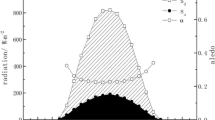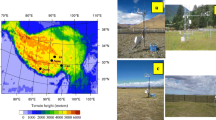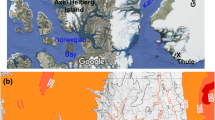Abstract
Climate change is predicted to lead to a drier and warmer climate in sub-tropical eastern Australia. Drier landscapes are more susceptible to fire, however, increases in daily precipitation extremes, and possible expansion of tropical weather systems into higher latitudes, implies that flooding may also become more common. We use the eddy-covariance technique to evaluate turbulent heat fluxes, and a net radiometer to measure surface albedo, over a groundwater dependent barrier island swamp. Measurements are made for dry and vegetated surface conditions, and following the natural occurrences of a wildfire and flooding. Results show that the wetland Bowen ratio has a value near 1 for typical dry and vegetated conditions, and is dominated by the latent heat flux when inundated by water. The largest changes in the partitioning of available energy into turbulent heat fluxes occur in the days immediately after the wildfire when the surface is dry, with the midday sensible heat flux nearly eight times greater than the latent heat flux. The key influences on energy partitioning are the atmospheric conditions for a dry and vegetated surface, and the surface conditions for either a burnt or a flooded surface.






Similar content being viewed by others
References
Amiro BD, Orchansky AL, Barr AG, Black TA, Chambers SD, Chapin FS III, Goulden ML, Litvak M, Liu HP, McCaughey JH, McMillan A, Randerson JT (2006) The effect of post-fire stand age on the boreal forest energy balance. Agric For Meteorol 140(1):41–50. https://doi.org/10.1016/j.agrformet.2006.02.014
Armstrong TJ, Cox ME (2002) The relationship between groundwater and surfacewater character and wetland habitats, Bribie Island, Queensland. In: Proceedings of the 7th IAH National Groundwater Conference, Darwin, Northern Territory, Australia
Beringer J, Hutley LB, Tapper NJ, Coutts A, Kerley A, O’Grady AP (2003) Fire impacts on surface heat, moisture and carbon fluxes from a tropical savanna in northern Australia. Int J Wildland Fire 12(4):333–340. https://doi.org/10.1071/WF03023
Beringer J, Hutley LB, Abramson D, Arndt SK, Briggs P, Bristow M, Canadell JG, Cernusak LA, Eamus D, Edwards AC, Evans BJ, Fest B, Goergen K, Grover SP, Hacker J, Haverd V, Kanniah K, Livesley SJ, Lynch A, Maier S, Moore C, Raupach M, Russell-Smith J, Scheiter S, Tapper NJ, Uotila P (2015) Fire in Australian savannas: from leaf to landscape. Global Change Biol 21(1):62–81. https://doi.org/10.1111/gcb.12686
Bradstock RA, Auld TD (1995) Soil temperatures during experimental bushfires in relation to fire intensity: consequences for legume germination and fire management in South-Eastern Australia. J Appl Ecol 32(1):76–84. https://doi.org/10.2307/2404417
Bremer DJ, Ham JM (1999) Effect of spring burning on the surface energy balance in a tallgrass prairie. Agric For Meteorol 97(1):43–54. https://doi.org/10.1016/S0168-1923(99)00034-9
Bureau of Meteorology (2017) Climate Data Online. Commonwealth of Australia. http://www.bom.gov.au/climate/data/. Accessed 5 Jan 2017
Cernusak LA, Hutley LB, Beringer J, Tapper NJ (2006) Stem and leaf gas exchange and their responses to fire in a north Australian tropical savanna. Plant Cell Environ 29(4):632–646. https://doi.org/10.1111/j.1365-3040.2005.01442.x
Chambers SD, Chapin FS (2002) Fire effects on surface-atmosphere energy exchange in Alaskan black spruce ecosystems: implications for feedbacks to regional climate. J Geophys Res Atmos 107:8145. https://doi.org/10.1029/2001JD000530
Chambers SD, Beringer J, Randerson JT, Chapin FS (2005) Fire effects on net radiation and energy partitioning: contrasting responses of tundra and boreal forest ecosystems. J Geophys Res Atmos 110(D09106). https://doi.org/10.1029/2004JD005299.
Cleverly J, Thibault JR, Teet SB, Tashjian P, Hipps LE, Dahm CN, Eamus D (2015) Flooding regime impacts on radiation, evapotranspiration, and latent energy fluxes over groundwater-dependent riparian cottonwood and saltcedar forests. Adv Meteorol 2015:14. https://doi.org/10.1155/2015/935060
CSIRO and Bureau of Meteorology (2015) Climate Change in Australia: Information for Australia’s Natural Resource Management Regions: Technical Report, Australia
Dowdy A, Abbs D, Bhend J, Chiew F, Church J, Ekström M, Kirono D, Lenton A, Lucas C, McInnes K, Moise A, Monselesan D, Mpelasoka F, Webb L, Whetton P (2015) East coast cluster report. In: Ekström M, Gerbing C, Grose M, Bhend J, Webb L, Risbey J (eds) Climate change in Australia: projections for Australia’s Natural Resource Management Regions: Cluster Reports, Australia.
Enright NJ, Keith DA, Clarke MF, Miller BP (2012) Fire regimes in Australian sclerophyllous shrubby ecosystems: heathlands, heathy woodlands and mallee woodlands, Flammable Australia: Fire Regimes, Biodiversity and Ecosystems in a Changing World. CSIRO Publishing, Collingwood, pp 215–234
Fan J, Oestergaard KT, Guyot A, Lockington DA (2014a) Measuring and modeling rainfall interception losses by a native Banksia woodland and an exotic pine plantation in subtropical coastal Australia. J Hydrol 515:156–165. https://doi.org/10.1016/j.jhydrol.2014.04.066
Fan J, Oestergaard KT, Guyot A, Lockington DA (2014b) Estimating groundwater recharge and evapotranspiration from water table fluctuations under three vegetation covers in a coastal sandy aquifer of subtropical Australia. J Hydrol 519:1120–1129. https://doi.org/10.1016/j.jhydrol.2014.08.039
Foken T, Leuning R, Oncley SR, Mauder M, Aubinet M (2012) Corrections and data quality control. In: Aubinet M, Vesala T, Papale D (eds) Eddy covariance: a practical guide to measurement and data analysis. Springer, Dordrecht, pp 85–131. https://doi.org/10.1007/978-94-007-2351-1_4
Gallant AJE, Hennessy KJ, Risbey J (2007) Trends in rainfall indices for six Australian regions: 1910–2005. Aust Meteorol Mag 56(4):223–239
Garratt JR (1990) The internal boundary layer: A review. Boundary-Layer Meteorol 50(1):171–203. https://doi.org/10.1007/bf00120524
Geoscience Australia (2015) Digital Elevation Model (DEM) of Australia derived from LiDAR 5 Metre Grid, Canberra, Australia. Accessed 28 Sep 2016
Gholz HL, Clark KL (2002) Energy exchange across a chronosequence of slash pine forests in Florida. Agric For Meteorol 112(2):87–102. https://doi.org/10.1016/S0168-1923(02)00059-X
Göckede M, Rebmann C, Foken T (2004) A combination of quality assessment tools for eddy covariance measurements with footprint modelling for the characterisation of complex sites. Agric For Meteorol 127(3–4):175–188. https://doi.org/10.1016/j.agrformet.2004.07.012
Görgen K, Lynch AH, Marshall AG, Beringer J (2006) Impact of abrupt land cover changes by savanna fire on northern Australian climate. J Geophys Res Atmos 111(D19). https://doi.org/10.1029/2005JD006860.
Govaerts YM, Pereira JM, Pinty B, Mota B (2002) Impact of fires on surface albedo dynamics over the African continent. J Geophys Res Atmos 107(D22):ACL 8-1-ACL 8-12. https://doi.org/10.1029/2002JD002388.
Gray MA, McGowan HA, Lowry AL, Guyot A (2018) Surface energy exchanges over contrasting vegetation types on a sub-tropical sand island. Agric For Meteorol 249:81–99. https://doi.org/10.1016/j.agrformet.2017.11.018
Guyot A, Cohard J-M, Anquetin S, Galle S, Lloyd CR (2009) Combined analysis of energy and water balances to estimate latent heat flux of a sudanian small catchment. J Hydrol 375(1–2):227–240. https://doi.org/10.1016/j.jhydrol.2008.12.027
Heilman JL, Heinsch FA, Cobos DR, McInnes KJ (2000) Energy balance of a high marsh on the Texas Gulf Coast: effect of water availability. J Geophys Res Atmos 105(D17):22371–22377. https://doi.org/10.1029/2000JD900334
Horst TW (1999) The footprint for estimation of atmosphere-surface exchange fluxes by profile techniques. Boundary-Layer Meteorol 90(2):171–188. https://doi.org/10.1023/a:1001774726067
Horst TW, Weil JC (1992) Footprint estimation for scalar flux measurements in the atmospheric surface layer. Boundary-Layer Meteorol 59(3):279–296. https://doi.org/10.1007/BF00119817
James R, Bulley G (2004) Bribie Island fire strategy. Queensland Parks and Wildlife Service, Brisbane
Jin Y, Roy DP (2005) Fire-induced albedo change and its radiative forcing at the surface in northern Australia. Geophys Res Lett 32(13):L13401. https://doi.org/10.1029/2005GL022822
Klingaman NP, Woolnough SJ, Syktus J (2013) On the drivers of inter-annual and decadal rainfall variability in Queensland, Australia. Int J Climatol 33(10):2413–2430. https://doi.org/10.1002/joc.3593
Kossin JP, Emanuel KA, Vecchi GA (2014) The poleward migration of the location of tropical cyclone maximum intensity. Nature 509(7500):349–352. https://doi.org/10.1038/nature13278
Lafleur P, Rouse WR, Hardill SG (1987) Components of the surface radiation balance of subarctic wetland terrain units during the snow-free season. Arctic Alpine Res 19(1):53–63. https://doi.org/10.2307/1551000
Leclerc MY, Foken T (2014) Footprints in micrometeorology and ecology. Springer, Berlin. https://doi.org/10.1007/978-3-642-54545-0
Li Y, Zhou L, Xu Z, Zhou G (2009) Comparison of water vapour, heat and energy exchanges over agricultural and wetland ecosystems. Hydrol Proc 23(14):2069–2080. https://doi.org/10.1002/hyp.7339
Liu H, Randerson JT, Lindfors J, Chapin III FS (2005) Changes in the surface energy budget after fire in boreal ecosystems of interior Alaska: An annual perspective. J Geophys Res Atmos 110(D13101). https://doi.org/10.1029/2004JD005158.
López-Saldaña G, Bistinas I, Pereira JMC (2015) Global analysis of radiative forcing from fire-induced shortwave albedo change. Biogeosciences 12(2):557–565. https://doi.org/10.5194/bg-12-557-2015
Lu J, Vecchi GA, Reichler T (2007) Expansion of the Hadley cell under global warming. Geophys Res Lett 34(6):L06805. https://doi.org/10.1029/2006GL028443
Mahrt L (2000) Surface heterogeneity and vertical structure of the boundary layer. Boundary-Layer Meteorol 96(1):33–62. https://doi.org/10.1023/a:1002482332477
Masseroni D, Facchi A, Romani M, Chiaradia EA, Gharsallah O, Gandolfi C (2015) Surface energy flux measurements in a flooded and an aerobic rice field using a single eddy-covariance system. Paddy Water Environ 13(4):405–424. https://doi.org/10.1007/s10333-014-0460-0
Massman WJ (2000) A simple method for estimating frequency response corrections for eddy covariance systems. Agric For Meteorol 104(3):185–198. https://doi.org/10.1016/S0168-1923(00)00164-7
Massman W, Clement R (2005) Uncertainty in eddy covariance flux estimates resulting from spectral attenuation. In: Lee X, Massman W, Law B (eds) Handbook of micrometeorology: a guide for surface flux measurement and analysis. Springer, Dordrecht, pp 67–99. https://doi.org/10.1007/1-4020-2265-4_4
McFarland D (1988) Fire and the vegetation composition and structure of sub-tropical heathlands in Southeastern Queensland. Aust J Bot 36(5):533–546. https://doi.org/10.1071/BT9880533
Melton JR, Wania R, Hodson EL, Poulter B, Ringeval B, Spahni R, Bohn T, Avis CA, Beerling DJ, Chen G, Eliseev AV, Denisov SN, Hopcroft PO, Lettenmaier DP, Riley WJ, Singarayer JS, Subin ZM, Tian H, Zürcher S, Brovkin V, van Bodegom PM, Kleinen T, Yu ZC, Kaplan JO (2013) Present state of global wetland extent and wetland methane modelling: conclusions from a model inter-comparison project (WETCHIMP). Biogeosciences 10(2):753–788. https://doi.org/10.5194/bg-10-753-2013
Moffett KB, Wolf A, Berry JA, Gorelick SM (2010) Salt marsh–atmosphere exchange of energy, water vapor, and carbon dioxide: effects of tidal flooding and biophysical controls. Water Resour Res 46(10):W10525. https://doi.org/10.1029/2009WR009041
Moureaux C, Ceschia E, Arriga N, Béziat P, Eugster W, Kutsch WL, Pattey E (2012) Eddy covariance measurements over crops. In: Aubinet M, Vesala T, Papale D (eds) Eddy covariance: a practical guide to measurement and data analysis. Springer, Dordrecht, pp 319–331. https://doi.org/10.1007/978-94-007-2351-1_12
Murphy BP, Bradstock RA, Boer MM, Carter J, Cary GJ, Cochrane MA, Fensham RJ, Russell-Smith J, Williamson GJ, Bowman DMJS (2013) Fire regimes of Australia: a pyrogeographic model system. J Biogeogr 40(6):1048–1058. https://doi.org/10.1111/jbi.12065
Nordbo A, Launiainen S, Mammarella I, Leppäranta M, Huotari J, Ojala A, Vesala T (2011) Long-term energy flux measurements and energy balance over a small boreal lake using eddy covariance technique. J Geophys Res Atmos 116(D2):D02119. https://doi.org/10.1029/2010JD014542
Oke TR (1987) Boundary layer climates. Methuen, New York
Paget MJ, King EA (2008) MODIS Land data sets for the Australian region. CSIRO Marine and Atmpospheric Research. Obtained from http://data.auscover.org.au/thredds/catalog/auscover/lpdaac-csiro/c5/catalog.html, made available by the AusCover facility (http://www.auscover.org.au) of the Terrestrial Ecosystem Research Network (TERN, http://www.tern.org.au). Accessed 28 Jan 2018
Papale D (2012) Data gap filling. In: Aubinet M, Vesala T, Papale D (eds) Eddy covariance: a practical guide to measurement and data analysis. Springer, Dordrecht, pp 159–172. https://doi.org/10.1007/978-94-007-2351-1_6
Queensland Herbarium (2013) Regional Ecosystem Description Database (REDD). Version 7.1, Department of Environment and Heritage Protection, Brisbane, Australia. Accessed 17 May 2013
Ramsar Convention Secretariat (2013) The Ramsar Convention Manual: a guide to the Convention on Wetlands (Ramsar, Iran, 1971), 6th edition, Gland, Switzerland
Risbey JS, Pook MJ, McIntosh PC, Wheeler MC, Hendon HH (2009) On the remote drivers of rainfall variability in Australia. Mon Weather Rev 137(10):3233–3253. https://doi.org/10.1175/2009mwr2861.1
San José JJ, Meirelles ML, Bracho R, Nikonova N (2001) A comparative analysis of the flooding and fire effects on the energy exchange in a wetland community (Morichal) of the Orinoco Llanos. J Hydrol 242(3–4):228–254. https://doi.org/10.1016/S0022-1694(00)00392-9
Santos AJB, Silva GTDA, Miranda HS, Miranda AC, Lloyd J (2003) Effects of fire on surface carbon, energy and water vapour fluxes over campo sujo savanna in central Brazil. Funct Ecol 17(6):711–719. https://doi.org/10.1111/j.1365-2435.2003.00790.x
Scientific Campbell (2015) EC150 CO2/H2O open-path gas analyzer. Campbell Scientific Inc., Logan
Spiers AG (1999) Review of international/continental wetland resources. In: Finlayson CM, Spiers AG (eds) Global review of wetland resources and priorities for wetland inventory. Supervising Scientist, Canberra
Stern H, de Hoedt G, Ernst J (2000) Objective classification of Australian climates. Aust Meteorol Mag 49:87–96
Stoy PC, Mauder M, Foken T, Marcolla B, Boegh E, Ibrom A, Arain MA, Arneth A, Aurela M, Bernhofer C, Cescatti A, Dellwik E, Duce P, Gianelle D, van Gorsel E, Kiely G, Knohl A, Margolis H, McCaughey H, Merbold L, Montagnani L, Papale D, Reichstein M, Saunders M, Serrano-Ortiz P, Sottocornola M, Spano D, Vaccari F, Varlagin A (2013) A data-driven analysis of energy balance closure across FLUXNET research sites: the role of landscape scale heterogeneity. Agric For Meteorol 171–172:137–152. https://doi.org/10.1016/j.agrformet.2012.11.004
Tryhorn L, Lynch A, Abramson R, Parkyn K (2008) On the Meteorological mechanisms driving postfire flash floods: a case study. Mon Weather Rev 136(5):1778–1791. https://doi.org/10.1175/2007MWR2218.1
Vickers D, Mahrt L (1997) Quality control and flux sampling problems for tower and aircraft data. J Atmos Ocean Technol 14(3):512–526. https://doi.org/10.1175/1520-0426(1997)014%3c0512:QCAFSP%3e2.0.CO;2
Watkins D (1999) Review of wetland inventory information in Oceania. In: Finlayson CM, Spiers AG (eds) Global review of wetland resources and priorities for wetland inventory. Supervising Scientist, Canberra
Webb EK, Pearman GI, Leuning R (1980) Correction of flux measurements for density effects due to heat and water vapour transfer. Q J R Meteorol Soc 106(447):85–100. https://doi.org/10.1002/qj.49710644707
Wendt CK, Beringer J, Tapper NJ, Hutley LB (2007) Local boundary-layer development over burnt and unburnt tropical savanna: an observational study. Boundary-Layer Meteorol 124(2):291–304. https://doi.org/10.1007/s10546-006-9148-3
Whelan RJ, Rodgerson L, Dickman CR, Sutherland E (2002) Critical life cycles of plants and animals: developing a process-based understanding of population changes in fire-prone landscapes. In: Bradstock RA, Williams JE, Gill MA (eds) Flammable Australia: the fire regimes and biodiversity of a continent. Cambridge University Press, Cambridge, pp 94–124
Wilczak J, Oncley S, Stage S (2001) Sonic anemometer tilt correction algorithms. Boundary-Layer Meteorol 99(1):127–150. https://doi.org/10.1023/A:1018966204465
Williams RJ, Bradstock RA, Cary GJ, Enright NJ, Gill AM, Liedloff AC, Lucas C, Whelan RJ, Andersen AN, Bowman DMJS, Clarke PJ, Cook GD, Hennessy KJ, York A (2009) The impact of climate change on fire regimes and biodiversity in Australia: A preliminary assessment. Department of Climate Change and Department of the Environment, Water, Heritage, and the Arts, Canberra
Wilson L, Manton MJ, Siems ST (2013) Relationship between rainfall and weather regimes in south-eastern Queensland, Australia. Int J Climatol 33(4):979–991. https://doi.org/10.1002/joc.3484
Acknowledgements
The authors acknowledge the comments from anonymous reviewers and the editors in improving this manuscript. The authors thank Andrew Lowry for assistance with data processing, Dr Junliang Fan for providing subsurface data for other sites on Bribie Island, Queensland Parks and Wildlife Service and HQ Plantations for allowing site access, and all field assistants. The Groundwater EIF funded the equipment for this research. This study was sponsored by The National Centre for Groundwater Research and Training (NCGRT), co-funded by the Australian Research Council and the National Water Commission. M. Gray received funding from an Australian Government Research Training Program Scholarship, and from the School of Earth and Environmental Sciences at The University of Queensland. A. Guyot was funded by a University of Queensland Fellowship. The funding bodies were not involved in the study design, or in data processing or analysis. The MODIS LAI data were obtained through TERN AusCover (http://www.auscover.org.au). TERN is Australia’s land-based ecosystem observatory delivering data streams to enable environmental research and management (TERN, http://www.tern.org.au). TERN is a part of Australia’s National Collaborative Research Infrastructure Strategy (NCRIS, https://www.education.gov.au/national-collaborative-research-infrastructure-strategy-ncris).
Author information
Authors and Affiliations
Corresponding author
Ethics declarations
Conflict of interest
The authors declare that they have no conflict of interest.
Additional information
Publisher’s Note
Springer Nature remains neutral with regard to jurisdictional claims in published maps and institutional affiliations.
Electronic supplementary material
Below is the link to the electronic supplementary material.
Rights and permissions
About this article
Cite this article
Gray, M.A., McGowan, H.A., Guyot, A. et al. Impacts of Fire and Flood on Land-Surface–Atmosphere Energetics in a Sub-tropical Barrier Island Freshwater Swamp. Boundary-Layer Meteorol 171, 129–149 (2019). https://doi.org/10.1007/s10546-018-0414-y
Received:
Accepted:
Published:
Issue Date:
DOI: https://doi.org/10.1007/s10546-018-0414-y




